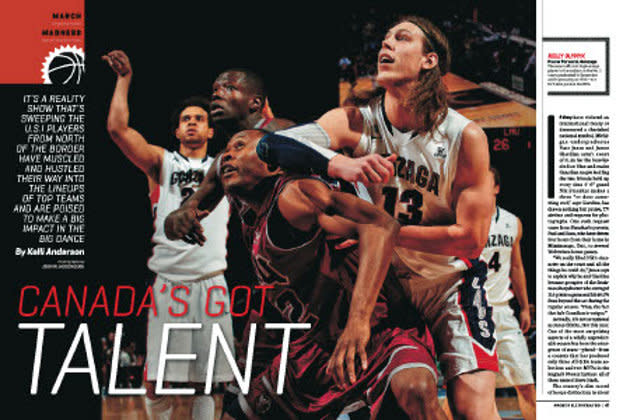Sports Illustrated spotlights Canadian basketball players set to star in March Madness
March Madness gets underway Tuesday as the NCAA basketball tournament's play-in games tip off, and there's plenty of Canadian content to be found. From #1 seed Gonzaga's Kelly Olynyk and Kevin Pangos to #5 Michigan's Nik Staukas to #5 UNLV's Anthony Bennett and Khem Birch to #13 New Mexico State's Canadian trio, this year's NCAA tournament has a substantial Canadian flavour. What's particularly interesting is that outlets outside Canada are starting to notice, and that's shown in a six-page feature in the March 18 issue of Sports Illustrated. Headlined "Canada's Got Talent", the piece (the full article isn't posted online yet, but here's some more information on it) by SI senior writer Kelli Anderson is a remarkable examination of many of the top NCAA players hailing from Canada and how they got to this level. Its existence alone is proof that the conversation around Canadian basketball players in the NCAA has changed, though; they've gone from extra reasons for Canadians to watch to crucial components on powerful teams.
It's notable that this change didn't happen overnight. Anderson interviews plenty of important basketball figures, including Canada Basketball CEO Wayne Parrish and Gonzaga coach Mark Few, but the most interesting comments on how the Canadian basketball landscape has changed come from former national team head coach and current Raptors analyst Leo Rautins. Rautins starred at Syracuse (as his son Andy also did decades later) in the 1980s and became the first Canadian drafted in the first round of the NBA draft in 1983, but he said his obsession with basketball was a rarity in the country at the time. That's dramatically different now, and Rautins attributes much of the change to the NBA's presence in Toronto with the Raptors (and its brief presence in Vancouver with the Grizzlies):
"Now you're seeing the kids who grew up with the NBA in their backyard," says Rautins, who served as Canada's national team coach from 2005 to '11. "I can remember flying into Toronto pre-NBA and looking down into driveways and seeing no hoops anywhere. Now you can see a basket on every garage."
While "a basket on every garage" might be a bit of an exaggeration, there's no dispute that basketball's much more popular in Canada now than it was during Rautins' playing career. The NBA having a team in Toronto's definitely a part of that, although the level of the Raptors' national presence is debatable (for example, their March 10 game against Cleveland drew just 64,000 viewers). There are other important elements at play too, though, including the effect of Steve Nash (who in addition to being the only Canadian NBA MVP or all-NBA selection so far, also has done great work at the grassroots level with his Youth Basketball League) and the recent success of Canadian players like Tristan Thompson and Cory Joseph. The combination of those and other factors (including the rising quality of high-level CIS programs like national champion Carleton and the recent launch of the National Basketball League of Canada) have certainly helped elevate basketball to a higher place on the Canadian sporting scene.
What's also particularly remar about Anderson's article is it details the radically different paths many of these current Canadian NCAA stars have taken. Some, like Marquette point guard Junior Cadougan, headed south of the border early in high school partly to escape rough neighbourhoods. Others, like Michigan's Staukas, went to prep schools in the States thanks to the poor high school basketball available in their area, while still others like Gonzaga's Olynyk and Pangos stayed north of the border for their high school careers. Some, like UNLV's Bennett, were instant fits at their school, while others like Bennett's Runnin' Rebels teammate Birch started elsewhere (Pitt, in his case) and transferred. These stars have come from dramatically different areas and backgrounds, and each of them plays a unique role, so it's tough to point to any one player and say "This is Canadian basketball" (although current high-school star Andrew Wiggins may change that). What's clear from Anderson's article is that the Canadian presence in NCAA basketball's on the rise, though, and it's at a point where Americans are starting to have to take notice.

 Yahoo Sports
Yahoo Sports 


